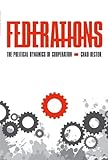Federations : The Political Dynamics of Cooperation / Chad Rector.
Material type: TextPublisher: Ithaca, NY : Cornell University Press, [2010]Copyright date: ©2011Description: 1 online resource (224 p.) : 4 charts/graphs, 1 mapContent type:
TextPublisher: Ithaca, NY : Cornell University Press, [2010]Copyright date: ©2011Description: 1 online resource (224 p.) : 4 charts/graphs, 1 mapContent type: - 9780801459177
- 320.4/049 22
- JC357 .R43 2009eb
- online - DeGruyter
| Item type | Current library | Call number | URL | Status | Notes | Barcode | |
|---|---|---|---|---|---|---|---|
 eBook
eBook
|
Biblioteca "Angelicum" Pont. Univ. S.Tommaso d'Aquino Nuvola online | online - DeGruyter (Browse shelf(Opens below)) | Online access | Not for loan (Accesso limitato) | Accesso per gli utenti autorizzati / Access for authorized users | (dgr)9780801459177 |
Frontmatter -- Contents -- Acknowledgments -- Introduction -- 1. Cooperation and Commitment -- 2. Contrived Symmetry through International and Federal Institutions -- 3. Australia’s Experiments with International Organization and Federation -- 4. Political Identity in Australia and New Zealand -- 5. Coercion and Union in Argentina and Germany -- 6. The Unraveling of East Africa and the Caribbean -- Conclusion -- References -- Index
restricted access online access with authorization star
http://purl.org/coar/access_right/c_16ec
Why would states ever give up their independence to join federations? While federation can provide more wealth or security than self-sufficiency, states can in principle get those benefits more easily by cooperating through international organizations such as alliances or customs unions.Chad Rector develops a new theory that states federate when their leaders expect benefits from closer military or economic cooperation but also expect that cooperation via an international organization would put some of the states in a vulnerable position, open to extortion from their erstwhile partners. The potentially vulnerable states hold out, refusing to join alliances or customs unions, and only agreeing to military and economic cooperation under a federal constitution.Rector examines several historical cases: the making of a federal Australia and the eventual exclusion of New Zealand from the union, the decisions made within Buenos Aires and Prussia to build Argentina and Germany largely through federal contracts rather than conquests, and the failures of postindependence unions in East Africa and the Caribbean.
Mode of access: Internet via World Wide Web.
In English.
Description based on online resource; title from PDF title page (publisher's Web site, viewed 26. Apr 2024)


